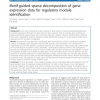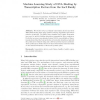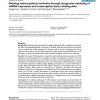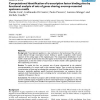155
click to vote
BMCBI
2011
14 years 8 months ago
2011
Background: Genes work coordinately as gene modules or gene networks. Various computational approaches have been proposed to find gene modules based on gene expression data; for e...
118
click to vote
BMCBI
2011
14 years 8 months ago
2011
Background: With the growing availability of entire genome sequences, an increasing number of scientists can exploit oligonucleotide microarrays for genome-scale expression studie...
125
click to vote
BIB
2010
14 years 10 months ago
2010
Genome-wide sequencing has enabled modern biomedical research to relate more and more events in healthy as well as disease-affected cells and tissues to the genomic sequence. Now ...
112
click to vote
PRIB
2010
Springer
14 years 11 months ago
2010
Springer
We studied 1372 LacI-family transcription factors and their 4484 DNA binding sites using machine learning algorithms and feature selection techniques. The Naive Bayes classifier a...
122
click to vote
NAR
2008
15 years 13 days ago
2008
Transcription factors (TFs) play key roles in controlling gene expression. Systematic identification and annotation of TFs, followed by construction of TF databases may serve as u...
110
click to vote
NAR
2000
15 years 22 days ago
2000
Transcription Regulatory Regions Database (TRRD) has been developed for accumulation of experimental information on the structure
141
click to vote
BMCBI
2004
15 years 24 days ago
2004
Background: Functional genomics studies are yielding information about regulatory processes in the cell at an unprecedented scale. In the yeast S. cerevisiae, DNA microarrays have...
120
click to vote
BMCBI
2004
15 years 24 days ago
2004
Background: Transcriptional regulation is a key mechanism in the functioning of the cell, and is mostly effected through transcription factors binding to specific recognition moti...
131
click to vote
BMCBI
2004
15 years 24 days ago
2004
Background: All known genomes code for a large number of transcription factors. It is important to develop methods that will reveal how these transcription factors act on a genome...
130
click to vote
BMCBI
2005
15 years 25 days ago
2005
Background: NemaFootPrinter (Nematode Transcription Factor Scan Through Philogenetic Footprinting) is a web-based software for interactive identification of conserved, non-exonic ...




